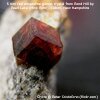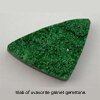 The word garnet is associated mainly with the dark red gem found in our grandmother?s jewel collection. In reality garnets come in all most all hues (like yellow, brown, orange, red, purple, black etc) except blue. It is definitely true that the red garnet has a longest history; however, there are many new and rare varieties of garnets that have been discovered in the last few decades.
The word garnet is associated mainly with the dark red gem found in our grandmother?s jewel collection. In reality garnets come in all most all hues (like yellow, brown, orange, red, purple, black etc) except blue. It is definitely true that the red garnet has a longest history; however, there are many new and rare varieties of garnets that have been discovered in the last few decades.
The garnet group has a very wide range of gems differing in properties and chemical composition. Infact, some gemstones are a combination of two or more garnets. (For e.g. Rhodolite or rhodonite, which is a combination of Almandine and Pyrope garnets.)
Garnet group is classified as follows
1) Almandine Garnet
Sub-Rhodolite
2) Pyrope Garnet
Sub-Rhodolite
3) Grossular Garnet
Sub-Massssive Hydrogrossular, Hessonite Garnet, Tsavorite Garnet.
4) Andradite Garnet
Sub-Demantoid, Topazolite, Melanite
5) Spessartite Garnet
6) Uvarovite Garnet
 There are around twenty species of garnet mineral. However, only five to six of them are common and commercially used for the jewellery making. These varieties are pyrope, almandine, grossularite, anderdite, spessartite and uvarovite. Again out of these uvarovite crystals are very small and are very rarely used in jewellery. There are many combinations of the above garnets that are also used in jewellery thus giving a wide range of hue and tones to choose from for the jewelry designers.
There are around twenty species of garnet mineral. However, only five to six of them are common and commercially used for the jewellery making. These varieties are pyrope, almandine, grossularite, anderdite, spessartite and uvarovite. Again out of these uvarovite crystals are very small and are very rarely used in jewellery. There are many combinations of the above garnets that are also used in jewellery thus giving a wide range of hue and tones to choose from for the jewelry designers.
I. Pyrope and Almandine Garnet
These two garnet crystals are many times found together as a part of one crystal. They have the same crystal structure and a very similar chemical composition; this makes it easy for the crystals to form together. These are called ?Pyralspite?. Pyralspite is not Pyrope nor almandine, but an intermediate between the two, it may be sometimes called as ?Umbalite?.
Although these two gems are mainly found together, they also exist as separate species. The consumers however, are not interested to know the distinction between the two garnet thus the dealer in the market do not really find it necessary to sell it with the relevant names. Gemologist however, can differentiate the two gem stones on the basis of it properties. It is almost not possible to distinguish the gems on the basis of its colour.
 The word garnet come from the Latin word ?Granatum? that means pomegranate and refers to the colour of the red garnet. The red garnets are called as ?Tambda? in India. This gem goes way back in history to the Bronze Age where the gem has been used in ornaments as beads. The use of garnet beads and inlay work has been evident between 3100 B.C. and 2300 B.C. in Egypt.
The word garnet come from the Latin word ?Granatum? that means pomegranate and refers to the colour of the red garnet. The red garnets are called as ?Tambda? in India. This gem goes way back in history to the Bronze Age where the gem has been used in ornaments as beads. The use of garnet beads and inlay work has been evident between 3100 B.C. and 2300 B.C. in Egypt.
Garnets were one of the gems that where entombed with Egyptian pharaohs as prized possessions for the after-life. It was used between 2000-1000 B.C. in Sweden and later in fourth and third century B.C. in Greece. Later in the middle ages, between the 450 ? 1500 A.D., red garnets where highly valued by nobility. With the discovery of the famous garnet mines in Bohemia, Czechoslovakia in 1500 A.D. it became a center for jewelry manufacturing and gem cutting, thus increasing the demand for the gem in Europe. However, after the 1800?s garnet started becoming less popular and its value decreased.
Garnet was treasured as a gem of faith, truth and constancy. It was also believed to be a remedy for hemorrhage, inflammatory diseases and also that it protected for wounds. According to some, in 1892 the king of Kashmir used garnet bullets against British army on the Kashmir frontier.
 Almandine garnet is an ferrous aluminium silicate (3 FeO Al 2 O3 3SiO2). Its specific gravity is 3.90 to 4.20 and refractive index range is between 1.76 to 1.81. Its hardness on Mohs scale is 7.5.
Almandine garnet is an ferrous aluminium silicate (3 FeO Al 2 O3 3SiO2). Its specific gravity is 3.90 to 4.20 and refractive index range is between 1.76 to 1.81. Its hardness on Mohs scale is 7.5.
Pyrope is a magnesium aluminium silicate (Mg3 Al 2 {SiO4}3). Its specific gravity is 3.70 to 3.90 and the refractive index range is between 1.73 to 1.76. The gem's hardness on Mohs scale is 7.25.
Rhodolite is a mixture of the Pyrope-Almandine group.
 Garnet Color
Garnet Color
Almandine- Almandine garnet's colour ranges from red-brownish red to violet-red and very dark red all most close to black.
Pyrope- The purest form of pyrope garnet is colourless. The gem owe?s its blood red to purplish red colour mainly to iron and not chromium like most of the other red gems do, thus it lacks the vibrant appeal of that of a ruby.
Rhodolite- Rhodolite garnet's fine purplish red colour makes it one of the most valuable gems in the red garnet group.
Cut
If the gem is very dark then it will be cut in a carbuncle cut (round for the top and curved for the bottom, it is also called as the hollow back) other wise light colored stones may be fashioned in all fancy cuts.
Prices of garnet can range from a mere US$0.50 per carat to US$100 per carat depending upon the clarity, luster and colour of the stone. Though big stones of above 7-8 carats with very exclusive luster and amazing colour can command very high prices in trade.
Almandine- Almandine or Almandite ( called in USA) deposits is found in many rock types. Large crystals of this gem are found in Burma (Myanmar). Other than this the gemstone is found in Thailand, Brazil, Tanzania, Mozambique, India, Sri Lanka, Zambia, Madagascar and the USA.
Pyrope: This gem deposit is found in India, Sri Lanka, Tanzania, Zambia, Namibia, Madagascar and USA.
Rhodolite: Rhodolite crystal was first found in Carolina in USA, but it is also found in country of Tanzania (Umba River Valley), Sri Lanka, India and Madagascar.
The simulants for these gems are as follows: Spinel, ruby, other reddish garnets, paste (synthetic), Tourmaline. Ironically they are simulants of each other as well.
Pyrope garnet is an indicator that there may be a diamond deposit around the area where this gem is found.
Natural color changing garnets and star garnets are also found in nature.
Garnet birthstone are worn by people born in the month of January. They can choose to wear any colours in the wide spectrum of garnets.
II. Grossularite Garnet
The Grossularite mineral group consists of three main garnets Massive hydrogrossular, Hessonite Garnet and Tsavorite garnet. (For hessonites and Tsavorites , please follow the links)
Chemical composition of Massive hydrogrossular Garnet
The chemical composition of grossularite group of garnet is calcium aluminium silicate (Ca3 Al 2 {SiO4}3). This garnet's hardness on Mohs scale is 7.25.
Massive Hydrogrossular Garnet's specific gravity is 3.36 to 3.55 and refractive index range is between 1.70 to 1.73. These garnets are found as rock as a massive crystal structure and found with other gems like Zoisite and Idocrase.
Physical properties hydrogrossular Garnet
Colour
Massive Hydrogrossular Garnet is mainly found in green and pink colours. The green variety of the gem is a very close stimulant of Jade, thus is it also marketed under the name Transvaal Jade. This can be misleading though.
Cut
This gemstone is usually used in carvings.
Massive Hydrogrossular Garnet is found in Canada, California (USA), Myanmar (Burma), and New Zealand and Utah mountains of USA.
Dying, irradiation and heat are some of the treatments that may be done on this garnet.
The green Massive hydrogrossular may be used in jewellery as a close substitute of Jade.
Because of its crystal structure the massive hydrogrossular garnet is mainly used for carvings, decorations and inlay work.
III. Andradite Garnet - Known for its brilliance and fire.
IV. Spessartite - Mandarin garnet
V. Uvarovite - Green garnets
History and General information of Uvavorite Garnet
 This gem was discovered in the year 1832 by a Russian amateur mineral collector. Named after Count S. S. Uvarov, (1765-1855), president of the St. Petersburg Academy and mineral collector.
This gem was discovered in the year 1832 by a Russian amateur mineral collector. Named after Count S. S. Uvarov, (1765-1855), president of the St. Petersburg Academy and mineral collector.
Chemical composition of Uvavorite Garnet
Uvarovite garnet is a chromium bearing calcium Chromium silicate (Ca3 Cr2 {SiO4}3). Its specific gravity is between 3.71 to 3.80 and refractive index range is between 1.798-1.864. This gem's hardness on Mohs scale is 6.5-7.5.
Physical properties of Uvavorite Garnet
Colour
It is only garnet which is consistently found in green colour. It has a lovely emerald green colour which appeals to the eye.
Cut
For its emerald green colour, any cut is preferred by collectors. Uvarovite garnets are usually found in small, closely packed crystals. Hence it is ideal to cut this gemstone into slabs and set into unique jewelry pieces.
Carat
It is not known to found in good big sized crystals, thus good quality gemstones can fetch a very high price.
Clarity
There are various inclusions found in the gem. However, only extremely clear gemstone gets a good value in the market.
Low quality gemstone with heavy inclusions can be bought for US$5- per carat onwards. But high quality gemstones are collector?s item and can fetch any price.
It is found in Spain, Russia, Quebec(Canada), Finland, Norway and South Africa.
1) Webster
2) Gemmology by Peter G.Read
3) Handbook of Gem Identification - Richard T.Liddicoat, jr
4) Gems & Crystals - From the American Museum of Natural History - Anna S.Sofianides and George E.Harlow.
Home | Add URL | About Us | Contact Us | Links | Privacy Policy | Resources | Sitemap | Design by Paper Tree
Copyright 2007 GehnaBazaar.com. All rights reserved. The information contained in this webpage may not be published, broadcast, rewritten or redistributed without a prior written consent. Natural Gemstones | Precious Gemstones | Jewellery Designers | Jewelry Institutes | Jewelery Design Institutes | Gemstone Information | Diamond Information | Gemmological Laboratories | Gem Labs | Jewelry Articles | Gold Price | Jewel Store | Buy and Sell Jewellery | Jewery Classes | Deisgn classes | Gemologists | Diamond Price